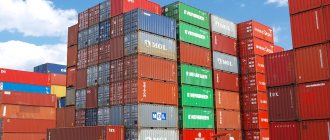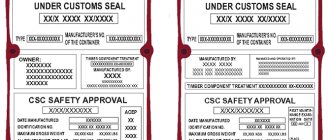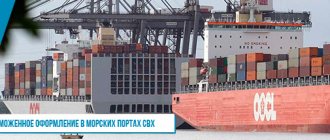General cargo (from the English general cargo “general cargo”) is any piece cargo, with or without packaging, that can be transported on vehicles without special conditions for loading or unloading, as is the case with bulk, bulk or liquid cargo. If bulk, liquid or bulk cargo is in containers (packed, rolled into skeins, poured into tanks, or otherwise prepared for convenient transshipment) or placed inside other cargo units, this is already general cargo.
As an example:
- if coal is transported without packaging (in a special hold of a ship or in bulk inside a wagon), then it is a bulk cargo;
- if coal is transported in a special container or big bag (which can be loaded into a vehicle or unloaded on site without opening the packaging), then this is already general cargo.
Although packaging is a defining property for general cargo, it is not a decisive parameter. Thus, general cargo may include piece cargo without special packaging: reinforced concrete products (reinforced concrete products), vehicles or special equipment, etc.
General and groupage cargo
The term is often confused with groupage cargo. Carriers working with general cargo can indeed accept goods/cargo from different clients for transportation in order to increase the profitability of the flight (the closer the occupied volume is to the maximum allowable, the higher the efficiency of one trip). But in reality they are not equivalent. The term “general cargo” refers to the definition of the category of cargo, on the basis of which the carrier will take certain measures for its delivery. And “consolidated cargo” is one of the possible options for working with general cargo.
Rules for transportation by sea
The main maritime rule associated with the transportation of groupage cargo is as follows: a specific container type is used for a specific product. Standard or “dry” designs are often used. To handle large cargo, 40-foot “tall” containers are prepared.
Sea transportation technology uses the following types of packaging:
- 0-foot – up to 26 tons, 33 m3;
- 20-foot with increased volume - 26 tons, 37.5 m3;
- 40-foot – up to 26 tons, 76 m3;
- with an open top - used for transporting oversized items;
- refrigerators – used if the rules for transporting goods require a special temperature regime;
- tank containers – used for transporting liquid and gaseous substances;
- platform – for heavy and oversized shipments.
Examples of product categories:
- rolled metal products (fittings, pipes, sheet metal, billets, ingots, etc.);
- roll-and-barrel loads (coils of wire or wire, drums, barrels, etc.);
- cargo containers (regardless of the type and filling, there can be both piece and liquid/bulk cargo inside);
- any bulk or liquid cargo in special packaging (big bags, bags, canisters);
- timber and lumber (logs, beams, boards, chipboards, OSB, plywood);
- finished concrete products (concrete products);
- cargo, special and any other mobile equipment (with and without its own drive);
- any piece goods in packaging (including household appliances or industrial equipment).
Additional terms and fees
Additional terms and charges are paid to local line agents usually through port forwarders.
Demurrage - demurrage, or penalties levied for excess use of a container from the moment it is unloaded at the terminal until the empty container is returned to the port (for import) or from the moment an empty container is received for loading until the loaded container is loaded onto the ship (for export ).
Depending on the line, the period of container use can sometimes be divided into Demurrage and Detention. Then Demurrage is penalties levied for excess use of a container from the moment it is unloaded at the terminal until the moment it is removed from the terminal. Detention - penalties levied for excess use of a container from the moment it is removed from the terminal until the empty container is returned to the port.
AdministrativeFee = B/LFee = DocsFee (other designations are possible) - local line agent fees for document processing. May be charged per bill of lading or per container.
Classification
By weight:
- heavy (weighing more than 5 tons),
- lightweight.
By dimensions:
- long (more than 3 m in length),
- oversized,
- ordinary.
Compatibility:
- chemically aggressive,
- neutral,
- susceptible to aggressive chemical influences.
Specific values of dimensions, weight and other indicators that allow the classification of a particular cargo are determined by GOST 26653-2015 “Preparation of general cargo for transportation”, as well as transportation rules for the corresponding mode of transport.
For marine:
- Safety rules for sea transportation of large and heavy cargo (KTG) RD 31.11.21.24-96;
- Rules for the carriage of goods in containers by sea;
- Code of Merchant Shipping of the Russian Federation;
- Hague rules.
For aviation:
- General rules for air transportation of passengers, baggage, cargo and requirements for servicing passengers, shippers, consignees (FAP 82);
- Guidelines for freight transportation on domestic routes of the USSR (RGP-85)
- Airport Maintenance Manual (ASM 346);
- Air Code of the Russian Federation.
For automobile:
- Charter of road transport and urban ground electric transport;
- Rules for the transportation of goods by road;
- Rules for the transportation of dangerous goods by road (POGAT and ADR).
For railway:
- In accordance with separate rules approved by orders of the Ministry of Transport or the Ministry of Railways of Russia (divided by types of cars, categories of goods, etc.);
- Charter of railway transport of the Russian Federation.
General concepts of international maritime transport of goods
In world practice, I distinguish two types of communications in maritime transport: - internal; — external transportation, in turn, includes the following types of transportation: international sea transportation of goods carried out during the export and import of goods; international maritime transport carried out between foreign ports. In addition, transportation by rivers and seas is gaining popularity. To carry out such transportation, vessels with certain seaworthiness and maneuverability are used. Based on the existing types of navigation, the following types of navigation in maritime transport are distinguished: - overseas sea voyages; - cabotage, which in turn includes two types: large cabotage, the navigation of sea vessels is carried out between different ports with ships calling at foreign ports; small cabotage is the navigation of ships within one or two basins; small cabotage does not involve the vessel calling at foreign ports. The practice of maritime navigation has developed its own basic forms of organization. The most commonly used forms are: - linear form, with this form, sea transportation of small consignments of goods is carried out, which, as a rule, are finished products and semi-finished products. There are the following maritime shipping lines: one-way lines - on such lines, ships of only one country or one shipping company are used; bilateral lines - ships from two countries or companies are used, respectively; conference lines - when ships from more than two companies or countries are used on the line. - regular form, this form is used in maritime transport in areas with regular cargo flow, i.e. Carrying out transportation on such lines, ships operate for more than three months. - voyage form, when carrying out international maritime transport, the form of organizing bulk cargo flows is used. Such cargoes, as a rule, are large consignments of homogeneous cargo, bulk or bulk. Deliveries of goods in this form have long-term contracts. — tramp form, this form of organization is used for the transportation of certain types of bulk cargo by sea vessels. Such cargo can be timber, ore, etc. Payment procedures for sea transportation use the following basic concepts: - freight rate, this rate is used to calculate the price of sea transportation, in essence, it is an indicator of the level of the world market for transporting a certain product by sea; - linear tariff, the tariff, in addition to the direct price for transportation, also includes the cost of loading and unloading work at the ports.
International maritime transport is regulated by the following regulatory documents, which are basic in the legal regulation of such transport: - Brussels Convention for the Unification of Certain Rules on Bills of Lading; — The Hague-Visby Rules; — UN Convention on the Carriage of Goods by Sea.
Advantages of general cargo
In comparison with other types of cargo that are transported without containers, general:
- better protected (not exposed to direct influence of external factors: temperature, precipitation, mechanical damage, etc.);
- easily reloaded from one transport to another (therefore suitable not only for direct, but also for mixed transport);
- do not require the use of special equipment during transportation (in most cases, universal vehicles can be used);
- can be supplied in small quantities (when transporting liquid, bulk and bulk cargo, this condition is difficult to fulfill).
How to use sea transportation?
We offer LCL Cargo System services. We carry out sea transportation from China and transport consolidated shipments by sea for more than 10 years. We know and comply with the types of technologies, as well as the types of rules adopted in international logistics.
Clients receive a range of services related to the transportation process. This includes developing the optimal route, processing the consignment at the ports of departure and arrival, placing goods in temporary storage warehouses, and customs clearance. We work in the most popular directions: Europe, Asia, North America, China, Japan, India. Contact our representatives using the contact number on the website to discuss the terms of cooperation and the cost of services.
Requirements
Special preparations must be made for the transportation process. The cargo requirements state that it must meet standards and be prepared, namely have:
- Correct packaging;
- Labeling;
- Control tape and seals;
In addition, it should not leak, have an odor, and it should not get wet. During transportation, the main characteristics of the goods are also taken into account. This helps prevent displacement, explosion, fire, damage due to heat, moisture, and corrosion. Transportation is carried out in a special mode - under conditions of humidity, ventilation, and at the desired temperature. Product placement is also very important. This is done on the basis of compatibility, which is divided into an aggressive group, neutral and susceptible to aggressive influence. As for packaging and containers, their task is to protect the product from external negative influences, so they must also meet special conditions. Based on their purpose, containers are divided into consumer, transport and additional, and according to their design they are divided into rigid, semi-rigid, soft.
Manufacturers can use metal, glass, and paper, shavings or foam plastic for internal protection. There are frequent cases when containers that weigh more than 1 ton are used. Then you cannot do without additional devices to help simplify loading and securing cargo. During transportation, the packaging must retain its original appearance, not be deformed, be convenient, and meet standards. A marine vehicle must have a reference book available with which you can check the packaging for compliance with GOST.
Important! Unpackaged cargo is bundled or loops and lugs can be used. We are talking about pipes and metal sheets.
Labeling conditions must also be observed. This inscription, consisting of signs and drawings, is applied to the goods as an indication of the characteristics, and to the cargo piece, which is necessary for high-quality transportation, facilitating the receipt and delivery of goods. It has four types:
- Commodity – applied by the manufacturer, contains information about the cargo, manufacturer;
- Transport – serial number of the warehouse, applied after receiving the cargo and checking the sender’s type of marking;
- Special – indicated by the sender if careful handling is necessary;
- Sending - is applied by the sender, has information about the sender, recipient, and place of issue.
If dangerous goods are transported, colored stickers are applied to them.
SCS General Express – express delivery
Even the transportation of ordinary general cargo may require the shipment of cargo at the very last moment. It is for such cases that we offer you our special service SCS Express . By choosing special conditions, you are guaranteed to send your cargo on the next flight, even if the cargo capacity is almost full. Sky Cargo Service team will select a solution with priority loading status, and you will receive a ready-made solution for your business .
Main advantages:
- Available throughout the Sky Cargo Service partner network.
- Exact transportation times, determined taking into account the time of cargo processing, flight and transit points.
- You choose the route, we guarantee support.
- Predictability of results, since you know exactly when the cargo will arrive.
- Confidence in airport-to-airport delivery with 24/7 tracking.
- Reducing the time spent by cargo at transit points.
- Logistics solutions specifically for: SCS General product.
- Transportation on both passenger and cargo aircraft.
- Load later and unload earlier: express cargo is loaded right at the plane.









